











Please upgrade your browser for modern web functionality, a better user experience and improved security.
Upgrade my browserSpecialist Knowledge
Need some help with your trip? Our advisors have travelled extensively and using their firsthand knowledge & experience can help craft your perfect holiday.The Stella Australis and Ventas Australis are luxurious, awe-inspiring cruise ships. The Stella (constructed in 2010) and the Ventas (built in 2017) consist of 100 cabins and can hold up to 210 passengers. During the cruise, there will be daily inland tours lasting approximately two hours.
These tours are organised and managed by the Australis Expedition Group and consist of walks through trails in the native Chilean forest and visits to glaciers. The tours include talks on the wildlife and plantlife of the area. A delicious whisky with the millenary ice, or a cup of hot chocolate will be served at the end of the excursions.
Your expedition cruise will journey in Tierra del Fuego, the myriad of islands, glaciers and channels between Ushuaia in Argentine and Punta Arenas on the Chilean side, with itineraries available in both directions.
Australis expedition ships offer a level of comfort, safety and efficiency rarely found in such remote places. Spacious cabins feature cozy beds, full bathrooms and panoramic views of the Patagonian nature unfolding outside.
The Stella Australis offers tourists a relaxed stay, while providing breathtaking sights from the decks. For the best in Chile travel choose Australis to reach all of Patagonia’s fabulous venues, attractions, and expeditions. Indulge in first class Chile travel onboard the Stella Australis. When you book our Patagonia cruise tours you have to opportunity to relax on a spacious cruise ship to Patagonia, with a beautiful atmosphere, and fine dining. Before you embark on your Patagonia adventure enjoy the comfort of cabins that provide you with incredible ocean views and lavish decor. Wine and dine, mix and mingle, and enjoy fabulous entertainment.



DIRECTION: PUNTA ARENAS TO USHUAIA
VESSEL: M/V STELLA AUSTRALIS (2010) & M/V STELLA VENTAS (2018)
Day 1 - Punta Arenas
Check in at 1385 O'higgins Street (Arturo Prat Port) between 13:00 and 17:00. Board at 18:00 (6 PM). After a welcoming toast and introduction of captain and crew, the ship departs for one of the remotest corners of planet Earth. During the night we cross the Strait of Magellan and enter the labyrinth of channels that define the southern extreme of Patagonian. The twinkling lights of Punta Arenas gradually fade into the distance as we enter the Whiteside Canal between Darwin Island and Isla Grande de Tierra del Fuego.
Day 2 - Ainsworth Bay & Tuckers Islets
By dawn the ship is sailing up Admiralty Sound (Seno Almirantazgo), a spectacular offshoot of the Strait of Magellan that stretches nearly halfway across Tierra del Fuego. The snowcapped peaks of Karukinka Natural Park stretch along the north side of the sound, while the south shore is defined by the deep fjords and broad bays of Alberto de Agostini National Park. We go ashore at Ainsworth Bay, which harbors copious bird life and a colony of southern elephant seals which can sometimes be spotted from the Zodiacs. Two guided excursions are available: one is along the edge of a stream, peat bog and beaver habitat to a waterfall-and-moss-covered rock face tucked deep inside a pristine sub-polar forest; the other is a more strenuous hike along the crest of a glacial moraine. Both afford views of Marinelli Glacier and the Darwin Mountains.
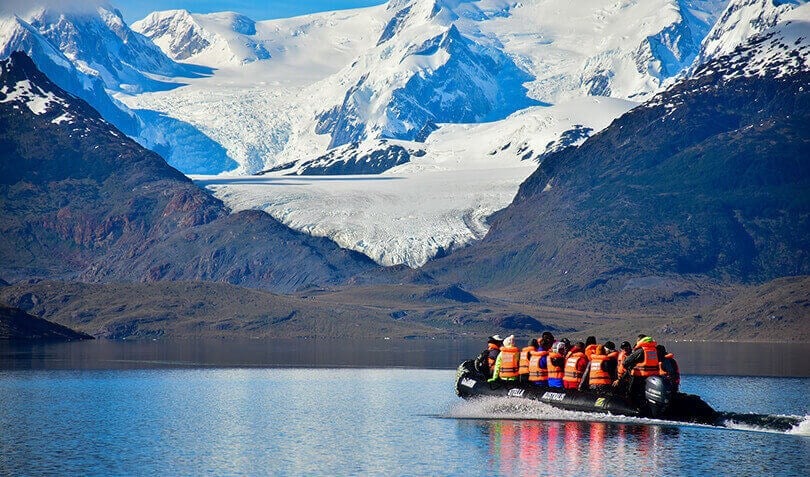
Leaving Ainsworth Bay behind, we sail west along the sound to the Tucker Islets. After lunch, we board the Zodiacs again for a close-up view of the Magellan penguins that inhabit the tiny islands. More than 4,000 penguins use Tucker as a place to nest, give birth and nurture their chicks. Many other bird species also frequent the area including king cormorants, oystercatchers, Chilean skuas, kelp geese, dolphin gulls, eagles and even the occasional Andean condor. In September and April -- when the penguins live elsewhere -- this excursion is replaced by a short walk to a glacier at nearby stunning Brookes Bay.
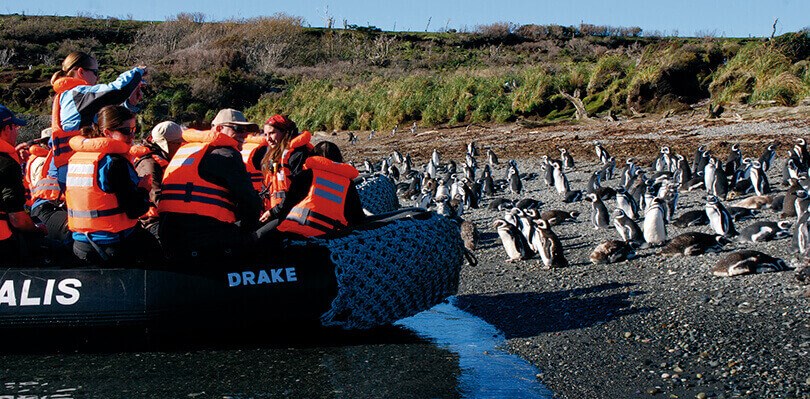
Day 3 - Pia Glacier & Glacier Alley
Overnight we sail around the western end of Tierra del Fuego via the very narrow Gabrial Channel, Magdalena Channel and Cockburn Channel. After rounding the remote Brecknock Peninsula, Stella Australis tacks eastward and enters the Beagle Channel again. By morning we are entering Pia Fjord and boarding the Zodiacs for a shore excursion to Pia Glacier. After disembarking we take a short hike to gain a panoramic view of the spectacular glacier, which extends from the mountaintops down to the sea or a longer much more difficult walk up a lateral moraine of the old Pia Glacier.
No one knows for certain how the hulking mass of snow and ice got its feminine moniker, but one theory says it was named for Princess Maria Pia of Savoy (1847-1911), daughter of the Italian king.
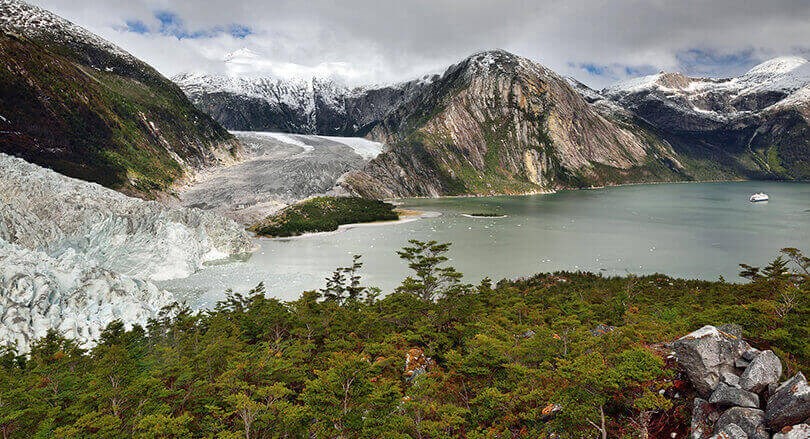
Back onboard the ship, we continue east along the Beagle Channel through an area called Glacier Alley. Living up to its name, the passage features a number of impressive tidewater glaciers flowing down from the Darwin Mountains and Darwin Ice Sheet on the north shore. Most of them named after European countries -- Holland, Italy, Germany, Spain and France.
Day 4 - Wulaia Bay & Cape Horn
During the early morning we navigate the narrow Murray Channel between Navarino and Hoste islands and drop anchor at historic Wulaia Bay, one of the few places in the archipelago where the human history is just as compelling as the natural environment. Originally the site of one of the region's largest Yámana aboriginal settlements, the bay was described by Charles Darwin and sketched by Captain FitzRoy in the 1830s during their voyages on the HMS Beagle. This area is also renowned for its mesmerizing beauty and dramatic geography. After a visit to the Australis-sponsored museum in the old radio station -- which is especially strong on the Yámana people and European missionaries in the area -- passengers have a choice of three hikes (of increasing degrees of difficulty) that ascend the heavily wooden mountain behind the bay. On all of these you will be strolling through an enchanted Magellan forest of lengas, coigües, canelos, ferns, and other endemic fauna to reach a panoramic viewpoint overlooking the bay. Before leaving Wulaia Bay, drop something into the wooden mail barrel inside the museum - letters or postcards meant to be hand delivered by future travelers - an ancient mariner tradition revived by Australis.

In the afternoon we cruise across Nassau Bay into the remote archipelago that includes Cape Horn National Park. Weather and sea conditions permitting, we shall go ashore on the windswept island that harbors legendary Cape Horn (Cabo de Hornos). Discovered in 1616 by a Dutch maritime expedition -- and named after the town of Hoorn in West Friesland -- Cape Horn is a sheer 425-meter (1,394-foot) high rocky promontory overlooking the turbulent waters of the Drake Passage. For many years it was the only navigation route between the Pacific and Atlantic, and was often referred to as the "End of the Earth." The park was declared a World Biosphere Reserve by UNESCO in 2005. The Chilean navy maintains a permanent lighthouse on the island, staffed by a lightkeeper and his family, as well as the tiny Stella Maris Chapel and modern Cape Horn Monument.
Day 5 - Ushuaia
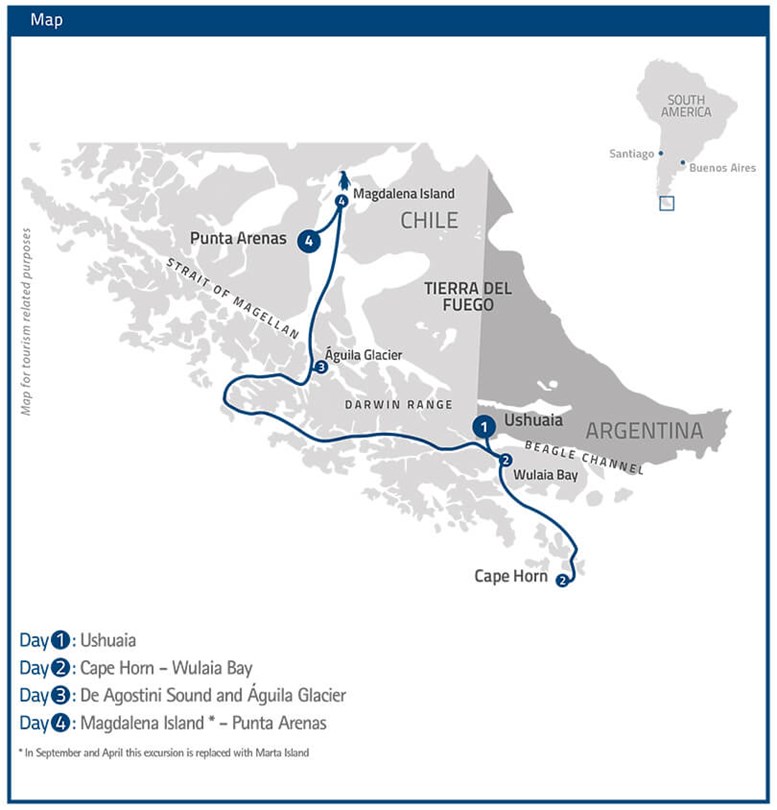
DIRECTION: USHUAIA TO PUNTA ARENAS
VESSEL: M/V STELLA AUSTRALIS
Day 1 - Ushuaia
Check in at 409 San Martín Ave. in downtown Ushuaia between 10:00 and 17:00 (10 AM-5 PM) on the day of your cruise departure. Board the M/V Stella Australis at 17:30 (5:30 PM). After a welcoming toast and introduction of captain and crew, the ship departs for one of the most remote corners of planet Earth. During the night we traverse the Beagle Channel and cross from Argentina into Chilean territorial waters. The lights of Ushuaia disappear as we turn into the narrow Murray Channel between Navarino and Hoste islands.
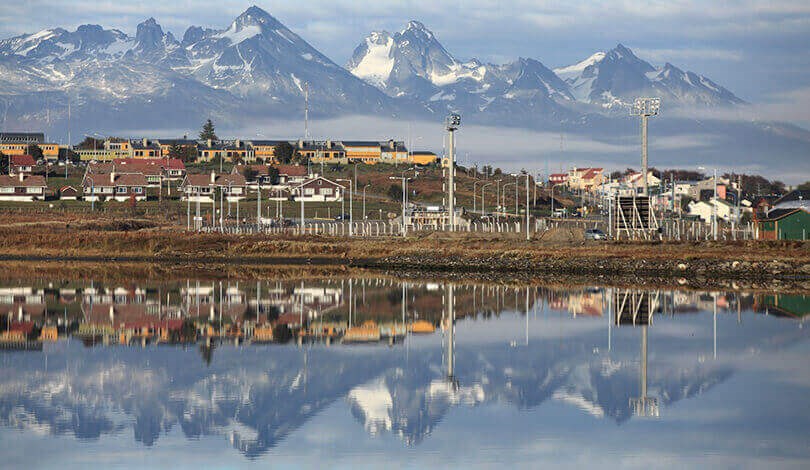
Day 2 - Cape Horn & Wulaia Bay
Around the break of dawn, Stella Australis crosses Nassau Bay and enters the remote archipelago that comprises Cape Horn National Park. Weather and sea conditions permitting, we shall go ashore on the windswept island that harbors legendary Cape Horn (Cabo de Hornos). Discovered in 1616 by a Dutch maritime expedition -- and named after the town of Hoorn in West Friesland -- Cape Horn is a sheer 425-meter (1,394-foot) high rocky promontory overlooking the turbulent waters of the Drake Passage. For many years it was the only navigation route between the Pacific and Atlantic, and was often referred to as the "End of the Earth." The park was declared a World Biosphere Reserve by UNESCO in 2005. The Chilean navy maintains a permanent lighthouse on the island, staffed by a lightkeeper and his family, as well as the tiny Stella Maris Chapel and modern Cape Horn Monument (currently awaiting repair after being damaged by fierce winds).
Sailing back across Nassau Bay, we anchor at fabled Wulaia Bay, one of the few places in the archipelago where the human history is just as compelling as the natural environment. Originally the site of one of the region’s largest Yámana aboriginal settlements, the bay was described by Charles Darwin and sketched by Captain FitzRoy in the 1830s during their voyages on HMS Beagle. This area is also renowned for its mesmerizing beauty and dramatic geography. After a visit to the Australis-sponsored museum in the old radio station -- which is especially strong on the Yámana people and European missionaries in the area -- passengers have a choice of three hikes (of increasing degrees of difficulty) that ascend the heavily wooded mountain behind the bay. On all of these you stroll through an enchanted Magellanic forest of lengas, coigües, canelos and ferns to reach panoramic viewpoints overlooking the bay.

Day 3 - Agostini Sound & Águila Glacier
After nightfall we reenter the Beagle Channel and sail westward along the southern edge of Tierra del Fuego into a watery wonderland protected within the confines of Alberto de Agostini National Park. Rounding the Brecknock Peninsula as the western extreme of Tierra del Fuego, Stella Australis is briefly exposed to the open Pacific. We then navigate a zigzag route through the Cockburn Channel, Magdalena Channel and Keats Fjord to reach scenic De Agostini Sound. Named after an Italian Salesian priest who worked among the region's indigenous people during the first half of the 20th century, De Agostini Sound is flanked by numerous glaciers and sheer saw-toothed peaks reminiscent of Torres del Paine. Our shore excursion this morning is Águila ("Eagle") Glacier, which hovers above a placid glacial lagoon surrounded by primeval forest. After a Zodiac landing on the beach, passengers hike around the edge of the lagoon to a spot near the base of the frozen facade. Condors can sometimes be seen winging high above, but there is always abundant bird life around the lagoon. This landing provides the perfect opportunity to experience the beauty of Patagonia’s sub-Antarctic rainforest and to see how the power of nature has molded the spectacular landscape.

Day 4 - Magdalena Island & Punta Arenas
After an overnight cruise through Magdalena Channel and back into the Strait of Magellan, we anchor off Magdalena Island, which lies about halfway between Tierra del Fuego and the Chilean mainland. Crowned by a distinctive lighthouse, the island used to be an essential source of supplies for navigators and explorers and is inhabited by an immense colony of Magellanic penguins. At the break of dawn, weather permitting, we go ashore and hike a path that leads through thousands of penguins to a small museum lodged inside the vintage 1902 lighthouse. Many other bird species are also found on the island. In September and April -- when the penguins dwell elsewhere -- this excursion is replaced by a ride aboard Zodiacs to Marta Island to observe South American sea lions. After a short cruise south along the strait, disembarkation at Punta Arenas is scheduled for around 11:30 AM.

Find inspiration from our selection of itinerary suggestions, a great starting point for your next trip
View More ToursSpecialist Advice & Ideas
Since 1999, we focus on carefully crafting unique and authentic travel experiences in Latin America and beyond.
Create Your Perfect Tour
Your holiday is tailored by our specialist advisors to fit your preferences using our extensive kowledge of each destination
The Best Local Guides
We have developed an extensive network of expert local guides, hand-picked to provide exclusive excursions and authentic insights.
Travel with Confidence
Our local guides are your hosts providing support, information and so you visit the main sites and experience life like a local.

Infuse your travels, with inspiration from our monthly newsletter.
INDIA: Fascinating Culture & Kembh Mela Festival
LANDMARK TOURS: Multi-Country & Cross Continent. New Cosmopolitan Tour: Buenos Aires, Iguazu, Rio
CHINA & INDIA: Local Life, People & Unique Cultures
GUIDES by Veloso Tours, are the best Local Hosts
PRIVATE VILLAS: Quality Time in exclusive settings
TRAVEL INSURANCE with extensive COVID-19 cover